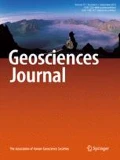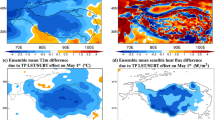Abstract
Understanding an isotopic evolution of a snowpack and its meltwater is crucial for both past and current climate and hydrological studies because the snowmelt is a substantial component of groundwater and surface runoff in temperate regions. To better understand the isotopic evolution of a snowpack, this study investigated the stable isotopic compositions of a snowpack and its melt using a physically-based one-dimensional model with different melting rates, which are dependent upon air temperature, amount of short-wave radiation that snow absorbed and aspect differences (north facing vs. south facing). The low melting rate produces a more curved and relatively larger isotopic differences between the earlier and later meltwater. On the other hand, the high melting rate yields a less curved isotopic trend and a smaller isotopic range. Low melting rate tends to make the snowpack isotopically heavier in both homogeneous and heterogeneous snowpack. Changes in melting rate at the surface were accompanied by the changes of both percolation velocity of liquid water and contact time between liquid water and snow (or ice). Therefore, the differences between isotopic values of the snowpack and meltwater decreases as the melting rate increases. Dependence of isotopic evolution of a snowpack and its meltwater on melting rate potentially important for studying snowmelt hydrology and ice cores for paleoclimate.
Similar content being viewed by others
References
Birkel, C., Soulsby, C., Tetzlaff, D., Dunn, S., and Spezia, L., 2012, High-frequency storm event isotope sampling reveals time-variant transit time distributions and influence of diurnal cycles. Hydrological Processes, 26, 308–316.
Colbeck, S.C., 1972, A theory of water percolation in snow. Journal of Glaciology, 11, 369–385.
Dahlke, H.E. and Lyon, S.W., 2013, Early melt season snowpack isotopic evolution in the Tarfala valley northern Sweden. Annals of Glaciology, 54, 149–156.
Elder, K., Dozier, J., and Michaelsen, J., 1991, Snow accumulation and distribution in an alpine watershed. Water Resources Research, 27, 1541–1552.
Feng, X., Taylor, S., Renshaw, C.E., and Kirchner, J.W., 2002, Isotopic evolution of snowmelt — 1. A physically based one-dimensional model. Water Resources Research, 38, 1217–1217.
Herrmann, A., Lehrer, M., and Stichler, W., 1981, Isotope input into runoff systems from melting snow covers. Nordic Hydrology, 12, 309–318.
Johnson, S.J., Dansgaard, W., and White, J.W.C., 1989, The origin of Arctic precipitation under present and glacier conditions. Tellus, 41B, 452–468.
Kustas, W.P. and Rango, A., 1994, A simple energy budget algorithm for the snowmelt runoff model. Water Resources Research, 30, 1515–1527.
Lee, J., Feng, X., Posmentier, E.S., Faiia, A.M., Osterhuber, R., and Kirchner, J.W., 2008a, Modeling of solute transport in snow using conservative tracers and artificial rain-on-snow experiments. Water Resources Research, 44, W02411, doi:10.1029/2006WR005477.
Lee, J., Nez, V.E., Feng, X., Kirchner, J.W., Osterhuber, R., and Renshaw, C.E., 2008b, A study of solute redistribution and transport in seasonal snowpack using natural and artificial tracers. Journal of Hydrology, 357, 243–254.
Lee, J., Feng, X., Posmentier, E.S., Faiia, A.M., and Taylor, S., 2009, Stable isotopic exchange rate constant between snow and liquid water. Chemical Geology, 260, 57–62.
Lee, J., Feng, X., Faiia, A.M., Posmentier, E.S., Kirchner, J.W., Osterhuber, R., and Taylor, S., 2010a, Isotopic evolution of a seasonal snowcover and its melt by isotopic exchange between liquid water and ice. Chemical Geology, 270, 126–134.
Lee, J., Feng, X., Faiia, A., Posmentier, E., Osterhuber, R., and Kirchner, J., 2010b, Isotopic evolution of snowmelt: A new model incorporating mobile and immobile water. Water Resources Research, 46, W11512, doi:10.1029/2009WR008306.
Lee, J. and Ko, K.-S., 2011, An energy budget algorithm for a snowpack-snowmelt calculation (in Korean with English abstract). Journal of Soil and Groundwater Environment, 16, 82–89.
Lee, J., Worden, J., Koh, D.-C., Yoshimura, K., and Lee, J.-E., 2013, A seasonality of δD of water vapor (850–500 hPa) observed from space over Jeju island, Korea. Geosciences Journal, 17, 87–95.
O’Neil, J.R., 1968, Hydrogen and oxygen isotope fractionation between ice and water. Journal of Physical and Chemistry, 72, 3683–3684.
Taylor, S., Feng, X., Kirchner, J.W., Osterhuber, R., Klaue, B., and Renshaw, C.E., 2001, Isotopic evolution of a seasonal snowpack and its melt. Water Resources Research, 37, 759–769.
Taylor, S., Feng, X., Renshaw, C.E., and Kirchner, J.W, 2002, Isotopic evolution of snowmelt — 2. Verification and parameterization of a one-dimensional model using laboratory experiments. Water Resources Research, 38, 1218–1218.
Theakstone, W.H., 2003, Oxygen isotopes in glacier river waters, Austre Oksindbreen, Okstindan, Norway. Journal of Glaciology, 29, 282–298.
Uemura, R., Matsui, Y., Yoshimura, K., Motoyama, H., and Yoshida, N., 2008, Evidence of deuterium excess in water vapor as an indicator of ocean surface conditions. Journal of Geophysical Research, 113, D19114, doi:10.1029/2008JD010209.
Unnikrishna, P., McDonnell, J.J., and Kendall, C., 2002, Isotope variation in a Sierra Nevada snowpack and their relation to meltwater. Journal of Hydrology, 260, 38–57.
Zhou, S., Nakawo, M., Hashimoto, S., and Sakai, A., 2008a, The effect of refreezing on the isotopic composition of melting snowpack. Hydrological Processes, 22, 873–882.
Zhou, S., Nakawo, M., Hashimoto, S., and Sakai, A., 2008b, Preferential exchange rate effect of isotopic fractionation in a melting snowpack. Hydrological Processes, 22, 3734–3740.
Author information
Authors and Affiliations
Corresponding author
Rights and permissions
About this article
Cite this article
Lee, J. A numerical study of isotopic evolution of a seasonal snowpack and its meltwater by melting rates. Geosci J 18, 503–510 (2014). https://doi.org/10.1007/s12303-014-0019-5
Received:
Accepted:
Published:
Issue Date:
DOI: https://doi.org/10.1007/s12303-014-0019-5




